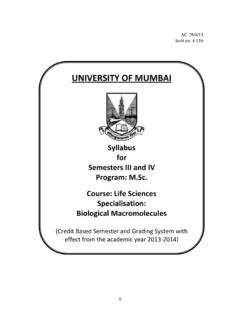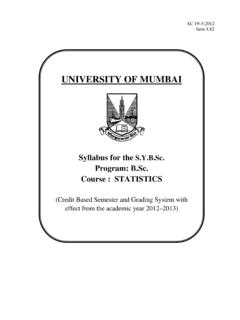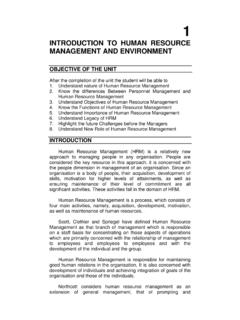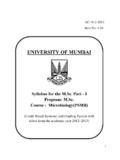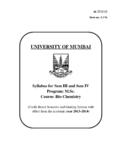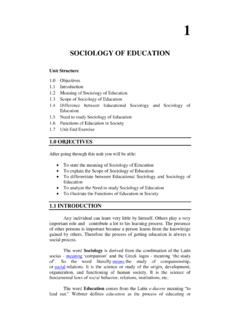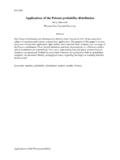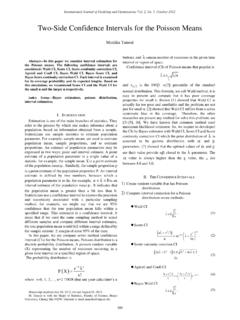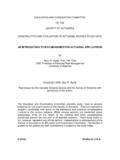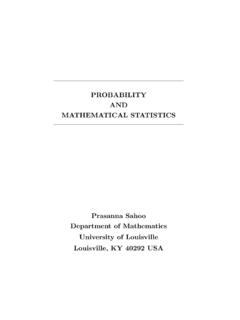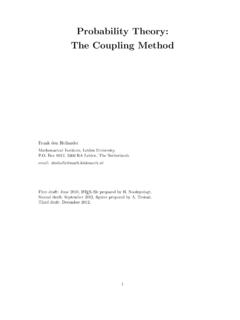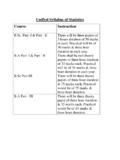Transcription of UN IVER SITY OF MUMBAI
1 UN (Crediteffe NIVERS yllaCou t Based Sect from RSITY abus foPrograurse: S Semestem the acad1 Y OF or Semam: and Grdemic ye AC ItemF MUM m V & STICS rading Sear 2013 27/2/1m No. S System w3 2014) 13 8 I with 2 STATISTICS Credit Based Semester and Grading System To be implemented from the Academic year 2013-2014 SEMESTER V Theory Course UNIT TOPICS Credits L / Week USST501 I probability -I 1 II probability -II 1 III Joint Moment Generating Function Trinomial & Multinomial distribution 1 IV Order Statistics 1 USST502 I Point Estimation and Properties of Estimator- I 1 II Properties of Estimator- II 1 III Methods of Estimation 1 IV Bayesian Estimation and Confidence Interval 1 USST503 I Epidemic Models 1 II Bioassay 1 III Clinical
2 Trials 1 IV Bioequivalence 1 USST504 I Mortality Tables 1 II Compound Interest And Annuities Certain 1 III Life Annuities 1 IV Assurance Benefits 1 Course PRACTICALS Credits L / Week USSTP05 Practicals of Course USST501 + Course USST502 3 8 USSTP06 Practicals of Course USST503 + Course USST504 3 8 3 Course Code Title Credits USST501 probability AND distribution THEORY Credits (60 lectures ) Unit I : probability I (i) Basic definitions: Random Experiment, Outcome, Event, Sample Space, Complementary, Mutually Exclusive, Exhaustive and Equally Likely Events.
3 (ii) Mathematical, Statistical, Axiomatic and Subjective probability . (iii) Sub populations and partitions. Derivation of a) Ar,n : Number of distinguishable distributions of putting r indistinguishable balls in n cells; b) Number of distinguishable distributions of putting r indistinguishable balls in n cells such that no cell is empty. (iv) Ordered samples and runs. (v) Probabilities based on a) Maxwell Boltzmann, Bose Einstein and Fermi Dirac Statistics.
4 (vi) Addition Theorem for (a) two (b) three events. (Ref. 1,2,5,7,8) 15 Lectures Unit II : probability II (i) Theorems on probability of realization of : (a) At least one (b) Exactly m (c) At least m of N events A1, A2, Matching and Guessing problems. (ii) Conditional probability : Multiplication Theorem for two, three events. Independence of two/three events - complete and pair wise. (iii) Bayes theorem. (Ref. 1,2,5,8) 15 Lectures Unit III: JOINT MOMENT GENERATING FUNCTION, TRINOMIAL AND MULTINOMIAL distribution (i) Definition and properties of Moment Generating Function (MGF) of two random variables of discrete and continuous type.
5 Necessary and Sufficient condition for independence of two random variables. Concept and definition of Multivariate MGF. (ii) Trinomial distribution : Definition of joint probability distribution of (X, Y). Joint moment generating function, moments rs where r=0, 1, 2 and s=0, 1, 2. Marginal & Conditional distributions. Their Means & Variances. Correlation coefficient between (X, Y). distribution of the Sum X+Y. (iii) Extension to Multinomial distribution with parameters (n, p1, p2,..pk-1) where p1+ p2,+..pk-1+ pk = 1. Expression for joint MGF.
6 Derivation of: joint probability distribution of (Xi, Xj). Conditional probability distribution of Xi 15 Lectures 4 given Xj =xj ( ,3,6,7) Unit IV: ORDER STATISTICS (i) Definition of Order Statistics based on a random sample. (ii) Derivation of: (a) Cumulative distribution function of rth order statistic. (b) probability density functions of the rth order statistic. (c) Joint probability density function of the rth and the sth order statistic ( r<s) (d) Joint probability density function of all n ordered statistics.
7 (iii) probability density function of Median (in the case of odd sample sizes) and Range for Uniform and Exponential distributions. ( ,3,4) 15 Lectures REFERENCES 1. Feller W: An introduction to probability theory and it s applications, Volume: 1, Third edition, Wiley Eastern Limited. 2. Hogg R V. & Craig Allen T.: Introduction to Mathematical Statistics, Fifth edition, Pearson Education (Singapore) Pvt. Ltd. 3. Mood A. M., Graybill F. A., Boes D. C.: Introduction to the theory of statistics, Third edition, Mcgraw- Hill Series.
8 4. Hogg R. V. and Tanis : probability and Statistical Inference, Fourth edition, McMillan Publishing Company. 5. Gupta S C & Kapoor V K: Fundamentals of Mathematical statistics, Eleventh edition, Sultan Chand & Sons. 6. Biswas S.: Topics in Statistical Methodology, First edition, Wiley Eastern Ltd. 7. Kapur J. N. & Saxena H. C.: Mathematical Statistics, Fifteenth edition, S. Chand and Company. 8. Chandra & Chatterjee D.: A First Course in probability , Second Edition, Narosa Publishing House. 5 Course Code Title Credits USST502 THEORY OF ESTIMATION Credits (60 lectures ) Unit I : POINT ESTIMATION AND PROPERTIES OF ESTIMATOR- I Notion of a parameter and parameter space.
9 Problem of Estimation, Definitions of Statistic, Estimator and Estimate. Properties of a good estimator: (a) Unbiasedness: Definition of an unbiased estimator, biased estimator, positive and negative bias, illustrations and examples (these should include unbiased and biased estimators for the same parameters). Proofs of the following results regarding unbiased estimators. (i) Two distinct unbiased estimators of ( ) give rise to infinitely many unbiased estimators. (ii) If T is an unbiased estimator of , then (T) is unbiased estimator of ( ) provided (.)
10 Is a linear function. (b) Consistency: Definition, Proof of the following theorem: An estimator is consistent if its bias and variance both tend to zero as the sample size tends to infinity. (c) Sufficiency: Concept and definition of Sufficiency, Neymann Factorization Theorem (without proof). Exponential family of probability distributions and Sufficient statistic. (d) Relative efficiency of an estimator. Illustrative examples. (Ref. 1,3,8) 15 Lectures Unit II : PROPERTIES OF ESTIMATOR- II Minimum variance unbiased estimator (MVUE), Uniqueness property of MVUE.


